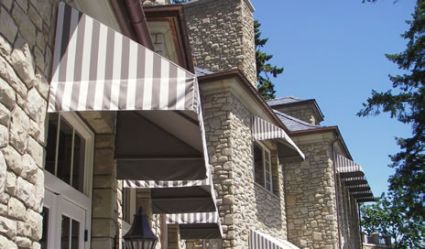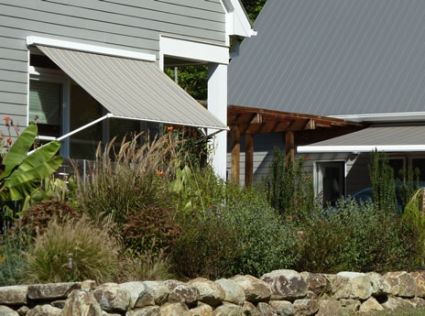Retractable Awning
This article has details for both retractable and fixed awnings.
Fabric color, weave, and material can all have significant impact on both visual and thermal performance.
Retractable awnings can be automated (motors, sensors, remote controls) with a big impact on both performance and cost. For automation details, see our window covering automation fact sheet.
Description
Awnings are roof-like shelters installed on a home’s exterior to shade windows from the sun’s heat, glare, and damaging ultraviolet (UV) rays. Awnings can also shade outdoor living spaces. By blocking the sun’s radiation outside of the home, before it reaches windows, awnings can be far more effective than interior blinds and shades at reducing indoor temperature increases from sunlight (solar heat gain).
Awnings are available in a wide range of colors and patterns. Stationary awnings are typically made of a durable fabric but can also be made of metal or fiberglass. They usually have a fixed aluminum frame and are designed for seasonal removal.
Retractable awning frames typically have hinged arms that allow for extension. Many retractable models are fully adjustable, providing tremendous flexibility in how much shade they provide. The awning fabric rolls up where the unit is attached to the building, with the roll often housed in a protective cover. Retractable awnings are often operated by a durable motor controlled by a wireless remote or hard-wired switch; manual operation with a long-handled crank or pull cord is a lower-cost option. Sophisticated controls on higher-end retractable awnings allow automatic extension in full sunlight and automatic retraction when high wind is detected.
Overall Thermal Performance
Although awnings are most commonly used to reduce solar heat gains in southern climates, they can also save energy in northern climates by reducing summertime solar heat gain. Awnings also provide shelter from direct solar radiation on patios or decks, for a comfortable outdoor environment on sunny days.
Awnings can affect thermal performance in two ways—reducing unwanted solar heat gain during periods when cooling is needed and enabling desirable solar heat gain during periods when heating is needed. Ideally, stationary awnings are configured and placed based on energy analysis or modeling to optimize shading performance throughout the year for a specific location on the home. Custom configuration of stationary awnings may be common for commercial buildings, but not
for most residential installations.
On a south wall, it is fairly easy to configure stationary awnings to block unwanted direct-beam summer sunlight while allowing desired lower-angle winter sunlight to reach the window. On east and west walls, because of low solar angles during early morning (east) and late afternoon (west) hours, awnings are not as effective unless they incorporate well-designed side coverings or can be extended to fully cover the entire window.
The benefits of retractable awnings are that they can be kept fully or partially retracted to allow beneficial sunlight into the home in cooler seasons, and extended when solar heat gain causes interior overheating or the need for air conditioning.
Awnings do not reduce heat loss through windows other than reducing exposure to nighttime sky radiation, which can reduce condensation potential in cold climates.

This stationary awning with closed-in sides provides nearly complete solar shading and only limits view of the sky.
Photos: Professional Awning Manufacturers Association
Key Benefits
- Reduce glare
- Reduce UV damage to home interiors
- May enhance building’s appearance
- Direct rain away from the window
- May reduce winter nighttime condensation
- Effectively block solar heat gain while maintaining much of view
- Maintain window egress
Key Drawbacks
- Customization needed for optimum performance in some cases, particularly for fixed awnings; may affect aesthetics.
- If deep enough to block most direct solar heat gain on east and west, may block more daylight and view than desired (adjustable awnings mitigate this problem).
- If fixed, removal possibly required before intense storms to prevent damage (retractable awnings need to be retracted).
Aesthetics
- Highly variable, depending on house style and homeowner tastes
- Wide variety of colors, materials, and configurations available
Tips/Cautions
- During design and sizing of awnings, encourage or require manufacturer or distributor to use computer modeling to show shading patterns on the windows throughout the day during different seasons.
- If living in a condominium or historic district, check for possible restrictions on installation of awnings.

This awning is open on the sides and fully retractable so that the view to the outdoors is better maintained. The awning fabric complements the home’s aesthetic.
Photo: Glen Raven, Inc.
When To Consider
- Glare is a dominant issue.
- Climate results in unwanted solar heat gain through large glazing area.
- The greater the unwanted solar heat gain, the more cost-effective this retrofit will be.
When to consider this retrofit—Ownership
| x | Homeowner |
| Apartment Renter - Long Term | |
| Apartment Renter - Short Term | |
| x | Live in a Condo* |
| x | Live in a Historical District* |
* Condominium regulations or historic building codes may provide design guidelines or limitations for the installation of awnings.
When to consider this retrofit—Window conditions
| x | Existing window single-glazed |
| x | Existing window double-glazed, no low-e* |
| x | Existing window double-glazed with low-e |
* low-emissivity coating
Recommended Installer
| Do it Yourself | |
| x | Contractor |
| x | Manufacturer or supplier |
Complementary Options
- Interior privacy such as blinds, drapes (insulated cellular shades for cold climate)
- Storm windows
Operation
| x | Motorized |
| x | Sensor |
| x | Manual |
Considerations
| 1 | 2 | 3 | 4 | 5 | |
| Ease of Installation (1 = easier) |
x(1st story) | x(2nd story) | |||
| Availability (1 = more available) |
x | x | |||
| Cost (1 = lower cost) |
x(1st story) | x | x(2nd story) |
Average Total Cost for 30- by 60-inch window
| Stationary Awning | $200 |
| Retractable Awning | $375 |
Digging Deeper
Energy Modeling Tools for Professionals
| x | RESFEN |
| x | Ecotect |
| x | Home Energy Saver |
| x | HEED |
References
“The Impact on Energy Use and Peak Demand of Awnings and Roller Shades in Residential Buildings”
To find window awnings, use this internet search term: window awnings
